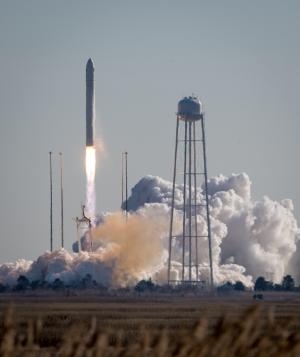Fri, Jan 10, 2014
Launch Delayed By A Day Due To High Levels Of Space Radiation
NASA commercial partner Orbital Sciences Corporation launched its Cygnus cargo spacecraft aboard the Antares rocket at 1307 EST Thursday from the Mid-Atlantic Regional Spaceport Pad 0A at NASA’s Wallops Flight Facility in Virginia for the Orbital-1 cargo resupply mission to the International Space Station. At the time of launch the station was flying about 260 miles over the Atlantic Ocean just off the coast of Brazil.

Cygnus will perform a series of engine firings to put it on track for a Sunday morning rendezvous with the station. When the vehicle reaches the capture point about 30 feet from the complex, Expedition 38 Flight Engineers Mike Hopkins and Koichi Wakata will use Canadarm2, the station’s 57-foot robotic arm, to reach out and grapple Cygnus at 0602 EST The crew then will use the robotic arm to guide Cygnus to its berthing port on the Earth-facing side of the Harmony node for installation beginning around 0620.
For its first official commercial resupply mission, designated Orbital-1, Cygnus is delivering 2,780 pounds of supplies to the space station, including vital science experiments for the Expedition 38 crew members aboard the orbiting laboratory. Orbital Sciences successfully proved the capability of the Cygnus spacecraft during its first and only demonstration flight to the station back in September 2013.
Cygnus will remain at the station until mid-February when it will be unberthed from the station for a destructive re-entry over the Pacific Ocean. That departure will clear the way for the arrival of Space Exploration Technologies’ SpaceX-3 commercial cargo mission aboard the Dragon spacecraft. These two back-to-back resupply missions by U.S. companies will mark a milestone in NASA’s ability to deliver critical new science payloads to the only laboratory in space.
The launch of Antares was scheduled for Thursday after a launch attempt on Wednesday was scrubbed due to an unusually high level of space radiation that exceeded constraints imposed on Antares. Orbital conducted a comprehensive review of data related to the radiation environment in space, further reviews and modeling of the rocket’s avionics systems, and the forecast for favorable terrestrial weather conditions at Wallops. Upon a deeper examination of the space weather environment, Orbital’s engineering team, in consultation with NASA, determined that the risk to launch success was within acceptable limits established at the outset of the Antares program.
With a busy weekend of Cygnus capture activities ahead of them, Hopkins, Wakata and Flight Engineer Rick Mastracchio enjoyed a mostly off-duty day Thursday aboard the station to relax and recharge. Hopkins and Wakata began their day with a series of eye exams for the Ocular Health study. Vision changes have been observed in some astronauts returning from long-duration spaceflight, and researchers want to learn more about its root causes and develop countermeasures to minimize this risk.
(Image provided by NASA)
More News
Terminal Radar Service Area Airspace surrounding designated airports wherein ATC provides radar vectoring, sequencing, and separation on a full-time basis for all IFR and participa>[...]
Aero Linx: Utah Back Country Pilots Association (UBCP) Through the sharing experiences, the UBCP has built upon a foundation of safe operating practices in some of the most challen>[...]
From 2010 (YouTube Edition): Imagine... Be The Change... Inspire FROM 2010: One of the more unusual phone calls I have ever received occurred a few years ago... from Anousheh Ansar>[...]
(Pilot) Felt A Shudder And Heard The Engine Sounding Differently, Followed By The Engine Chip Detector Light On April 14, 2025, about 1800 Pacific daylight time, a Bell 206B, N1667>[...]
Also: AMA Names Tyler Dobbs, More Falcon 9 Ops, Firefly Launch Unsuccessful, Autonomous F-16s The Air Force has begun ground testing a future uncrewed jet design in a milestone tow>[...]
 ANN's Daily Aero-Term (05.07.25): Terminal Radar Service Area
ANN's Daily Aero-Term (05.07.25): Terminal Radar Service Area ANN's Daily Aero-Linx (05.07.25)
ANN's Daily Aero-Linx (05.07.25) Classic Aero-TV: Anousheh Ansari -- The Woman Behind The Prize
Classic Aero-TV: Anousheh Ansari -- The Woman Behind The Prize NTSB Prelim: Bell 206B
NTSB Prelim: Bell 206B Airborne-NextGen 05.06.25: AF Uncrewed Fighters, Drones v Planes, Joby Crew Test
Airborne-NextGen 05.06.25: AF Uncrewed Fighters, Drones v Planes, Joby Crew Test



